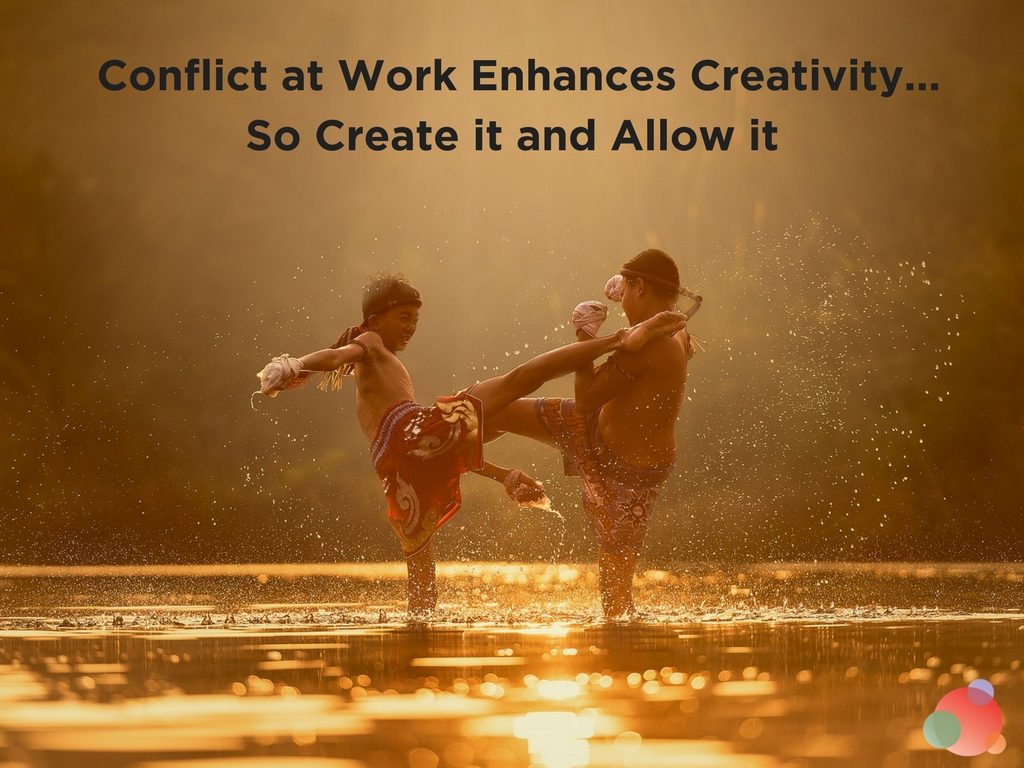 We work in a creative industry; one that is rapidly evolving.
We work in a creative industry; one that is rapidly evolving.
And, with that rapid evolution, conflict at work can bubble up among your creative team.
When you see conflict cropping up among your staff, what is your first instinct?
Do you:
- Squash it. I need my team focused on the work, not fighting with one another.
- Embrace it. Creativity is messy, but the result is worth the mess.
Many company cultures fall firmly into the “A” camp.
Managers are trained to soften disagreements, smooth over conflicts, and ward off clashes before they happen—or at least before people raise their voices.
This might be a great management tactic for leading automatons, but is the exact opposite of how you need to lead creators.
Conflict and creativity are necessary partners.
Conflict at Work Enhances Creativity
Think about one of your first ideas for a big project—the first copy you wrote for your website, the first pitch deck you built, the first campaign you designed for a new product rollout.
Your first was likely not your best, nor the one you ultimately used.
If your first idea was also your last, with no competition for other options, you’re likely suffering from a serious deficiency of creative conflict at work.
We may avoid conflict because it’s uncomfortable.
We not only drown out potentially great ideas, we also breed a negative work culture for creative professionals we fight so hard to hire.
They stop bringing new ideas to managers for fear of admonishment.
They disappear into themselves.
Or spend time complaining to the rest of the staff about what they’d do differently, if only they could raise their voice at work.
The job of managers in creative industries is to marry conflict to creativity.
Not only should you stop fighting respectful disagreements among your team, but you should also encourage it through thoughtful matchmaking.
By bringing dynamic personalities together, you can ignite, protect, and sustain the creative spark of your team.
Here’s how to get it right.
Protect the Passionate Players
This is about remembering why you show up to work in the first place. And why you want your team members to show up.
If you have people in the room who view their work as just an average day job, then help them find a new job.
Creative teams feed on energy and work best when everyone is driven by their passion.
This might go against every instinct you have to retain employees who show up on time and hit their deadlines, but who aren’t engaged enough to disagree or fight for an idea. Resist instinct.
And when it’s time for these folks to leave your team, get out of their way.
Encourage Arguments with Purpose
There is no point in purposeless arguments. They drain everyone’s energy without delivering results.
Conflict at work is valuable when those involved have a shared goal: to move the business forward.
Creative conflict is not about yelling contrarian ideas just for the sake of disagreement or shouting down others’ input without offering alternatives.
There is a distinct difference between fighting for an approach you believe in, and fighting because you believe the boss wants you to.
Make sure everyone knows the difference.
Create Unlikely Partnerships
Remember in elementary school, when you had the chance to work with a partner? You’d run to your best friend. “I’m with her!”
The same thing happens in the workplace. Team members are most likely to opt-in to work with colleagues whose temperament, work style, and ideas align with theirs.
Don’t let them. Pair up the opposites.
Take your most process-oriented person and have them work with a minimalist. Put an introvert with an extrovert. Assign a project to your team analyst and your wordsmith.
They’ll all have awkward moments together.
But that awkwardness is more likely to yield something more beautiful than a bunch of partnerships that reinforce existing ideas.
Push Them Out of Comfort Zones and Leave Them Alone
There is a Goldilocks principle to leading employees into the uncomfortable places where creative work happens.
If you push too hard, too fast, they’ll resist. If you don’t push, they’ll settle comfortably into a rut.
Examine the effect you have on people and change your approach if it’s not right.
The more you know yourself, the better you can modify your behavior to get the most out of your team.
As you nudge them toward places where they can do their best work, remember to pick moments to step back.
People need time to think, even if they do thrive on collaboration and group brainstorms.
Approach Conflict with Positive Intent
So many people avoid conflict because they equate it with negativity.
But they shouldn’t.
When you bring positive intent to conflict at work, you’re in a better position to harness disagreements to fuel creativity.
Model this in your behavior and assume others do, as well.
Weed Out Gossip
If you can foster constructive friction among your team, they will do better work.
They will figure out what they care about, learn from each other, and land on ideas not previously considered.
This kind of friction, however, is different from the kind which undermines teams.
Gossips and complainers can bring down a company culture.
When you see people throwing jabs from the sidelines without getting into the fray themselves, take note.
These actions undermine all the good work happening in your organization.
Opt-in for Awkwardness
At times, the creative process can be frustrating, awkward, uncertain, and tense.
So can conflict at work.
And yet, that discomfort is a necessary part of creation.
When managers tamp it down, they limit their teams to rote processes and well-worn paths.
Instead, we should embrace those awkward conflicts which can help lead our teams to their best work.